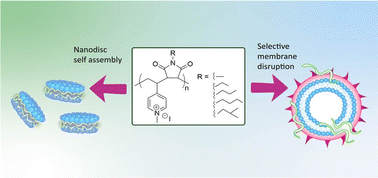Membrane interaction and selectivity of novel alternating cationic lipid-nanodisc assembling polymers†
Abstract
Synthetic polymer nanodiscs are self-assembled structures formed from amphipathic copolymers encapsulating membrane proteins and surrounding phospholipids into water soluble discs. These nanostructures have served as an analytical tool for the detergent free solubilisation and structural study of membrane proteins (MPs) in their native lipid environment. We established the polymer–lipid nanodisc forming ability of a novel class of amphipathic copolymer comprised of an alternating sequence of N-alkyl functionalised maleimide (AlkylM) of systematically varied hydrocarbon chain length, and cationic N-methyl-4-vinyl pyridinium iodide (MVP). Using a combination of physicochemical techniques, the solubilisation efficiency, size, structure and shape of DMPC lipid containing poly(MVP-co-AlkylM) nanodiscs were determined. Lipid solubilisation increased with AlkylM hydrocarbon chain length from methyl (MM), ethyl (EtM), n-propyl (PM), iso-butyl (IBM) through to n-butyl (BM) maleimide bearing polymers. More hydrophobic derivatives formed smaller sized nanodiscs and lipid ordering within poly(MVP-co-AlkylM) nanodiscs was affected by nanodisc size. In dye-release assays, shorter N-alkyl substituted polymers, particularly poly(MVP-co-EtM), exhibited low activities against eukaryotic mimetic POPC membrane and increased their liposome disruption as POPC : POPG membrane mixtures increased in their anionic POPG component, resembling the charge profile of bacterial membranes. These trends in membrane selectivity were transferred towards native cell systems in which gram-positive Staphylococcus aureus and gram-negative Acenobacter baumannii bacterial strains were relatively susceptible to disruption by hydrophobic n-butyl- and n-propyl-poly(MVP-co-AlkylM) derivatives compared to human red blood cells (HRBCs), with a more pronounced selectivity resulting from poly(MVP-co-PM). Such selective membrane interaction by less hydrophobic polymers provides a framework for polymer design towards applications including selective membrane component solubilisation, biosensing and antimicrobial development.



 Please wait while we load your content...
Please wait while we load your content...